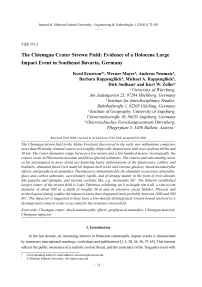The Chiemgau crater strewn field: evidence of a Holocene large impact event in Southeast Bavaria, Germany
Автор: Ernstson Kord, Mayer Werner, Neumair Andreas, Rappenglck Barbara, Rappenglck Michael A., Sudhaus Dirk, Zeller Kurt W.
Журнал: Журнал Сибирского федерального университета. Серия: Техника и технологии @technologies-sfu
Статья в выпуске: 1 т.3, 2010 года.
Бесплатный доступ
The Chiemgau strewn field in the Alpine Foreland discovered in the early new millennium comprises more than 80 mostly rimmed craters in a roughly elliptically shaped area with axes of about 60 km and 30 km. The crater diameters range between a few meters and a few hundred meters. Geologically, the craters occur in Pleistocene moraine and fluvio-glacial sediments. The craters and surrounding areas so far investigated in more detail are featuring heavy deformations of the Quaternary cobbles and boulders, abundant fused rock material (impact melt rocks and various glasses), shock-metamorphic effects, and geophysical anomalies. The impact is substantiated by the abundant occurrence of metallic, glass and carbon spherules, accretionary lapilli, and of strange matter in the form of iron silicides like gupeiite and xifengite, and various carbides like, e.g., moissanite SiC. The hitherto established largest crater of the strewn field is Lake Tüttensee exhibiting an 8 m-height rim wall, a rim-to-rim diameter of about 600 m, a depth of roughly 30 m and an extensive ejecta blanket. Physical and archeological dating confine the impact event to have happened most probably between 1300 and 300 B.C. The impactor is suggested to have been a low-density disintegrated, loosely bound asteroid or a disintegrated comet in order to account for the extensive strewn field.
Сhiemgau crater, shock-metamorphic effects, geophysical anomalies, chiemgau material, chiemgau impactor
Короткий адрес: https://sciup.org/146114525
IDR: 146114525 | УДК: 551.3


